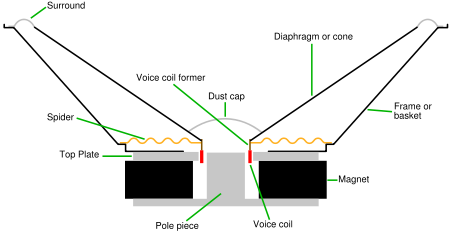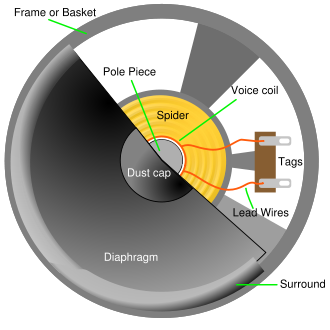|
SPEAKERS.net |
||
|
|
Dynamic
loudspeakers The traditional design is a semi-rigid paper fibre cone and a coil of fine wire (usually copper), called the voice coil attached to the apex of the cone. A "gap" is a small circular hole, slot or groove which allows the voice coil and cone to move back and forth. The coil is oriented coaxially inside the gap made with a permanent magnet. The gap is also where the magnetic field is concentrated. One magnetic pole is outside the coil, whilst the other is inside the voice coil. In addition to the magnet, voice coil, and cone, dynamic speakers usually also include a suspension system to provide lateral stability and make the speaker components return to a neutral point after moving. A typical suspension system includes the spider, which is at the apex of the cone, often of "concertina" form; and the surround, which is at the base of the cone. The parts are held together by a chassis or basket. When an electrical signal is applied, a magnetic field is induced by the electric current in the coil which becomes an electromagnet.
The coil and the permanent magnet interact with magnetic force which causes the coil and a semi-rigid cone (diaphragm) to vibrate and reproduce sound at the frequency of the applied electrical signal. When a multi-frequency signal is applied, the complex vibration results in reproduction of the applied signal as an audio signal. Driver cones may be constructed of a variety of materials, including paper, metal, various polypropylenes, and kevlar. Baskets must be designed in order to preserve rigidity and are typically cast or stamped metal, although injection-molded plastic baskets are becoming much more common in recent years. The size and type of magnets can also differ. Sometimes, larger and more powerful magnets are associated with higher quality speakers. Tweeters are subject to a unique set of variables and parameters; their design and construction is extremely variable. Despite marketing claims, lighter and more rigid cones do not always sound better. The weight and damping of the cone in a dynamic speaker should be appropriate for the characteristics of the rest of the driver and enclosure in order to produce accurate sound. The cross-section image shows the construction of a speaker that uses an overhung coil. This term is used when the coil's height is greater than the gap's, and this construction is most commonly used. This construction attempts to keep the number of windings within the gap (and hence the force experienced by the coil) to be constant, as the coil moves back and forth. The other construction is the underhung construction. Here, the voice coil's height is smaller than the gap's. This construction attempts to keep the magnetic flux constant across the coil as it moves back and forth (this also results in the coil experiencing a constant force). Both methods try to achieve the same thing — a linear force on the coil, and each has its pros and cons. The overhung design offers softer or gradual non-linearity (compression) when the coil starts exceeding the Xmax limits. Speakers using overhung coils have better efficiency and power handling. The underhung design offers greater linearity within the Xmax limits but as the coil starts exceeding Xmax limits the non-linearity (and hence distortion) rapidly increases. This design also requires a more powerful magnet, and so speakers using underhung coils tend to be less efficient [3]. Xmax is the maximum linear peak-to-peak travel of the voice coil. This means that the displacement of the voice coil is a linear function of the input voltage within the limits specified by Xmax. |
|
|
Copyright © 1996 - 2024 Amazon Internet - All Rights Reserved. Mozilla/5.0 AppleWebKit/537.36 (KHTML, like Gecko; compatible; ClaudeBot/1.0; +claudebot@anthropic.com) [3.145.183.137] |
||

